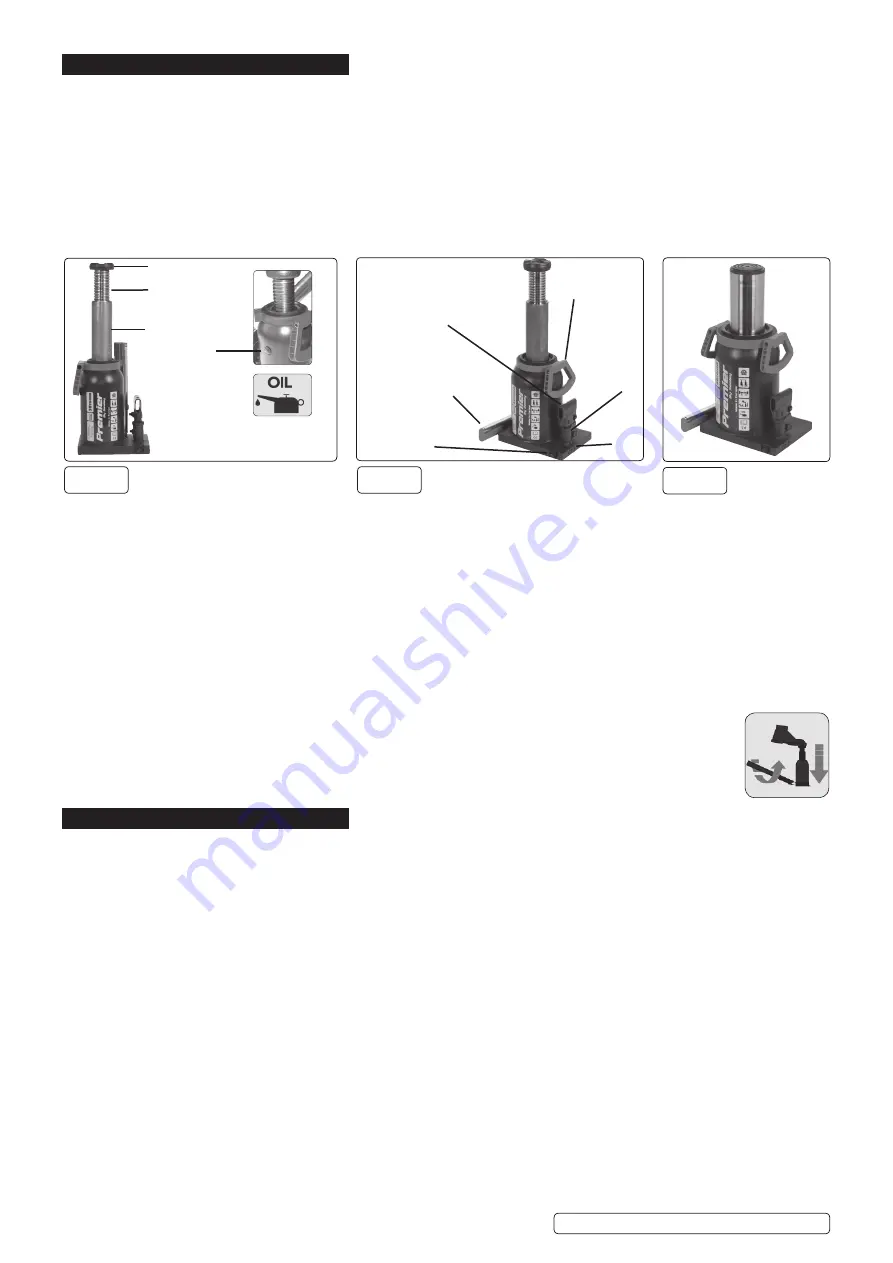
4. OPERATION
IMPORTANT SAFETY WARNING! ALWAYS USE RATED STANDS
Please remember a jack is a lifting and lowering device and is not designed to support a load. Never get underneath a vehicle supported
only by a jack; your life is at risk. We stock a comprehensive range of axle stands, for example, please see relevant catalogue section for
full details. The jack is not limited to vehicle use only, with many applications in the engineering and construction industries.
WARNING! Before use refer to section 1. SAFETY
4.1. PURGING THE JACK
Purge the hydraulic system in order to eliminate any air that may have accumulated in transit or whilst stored:
a)
Place the telescopic jack lever over the release valve and turn anti clockwise to open the valve.
b)
Insert the telescopic jack lever into the sleeve of the hydraulic pump.
c)
Pump several times to ensure complete evacuation of air from the system.
d)
When complete place the telescopic lever over the release valve and turn clockwise to close.
PBJ20, PBJ30, PBJ50 | Issue 3 (H,F) 17/01/19
Original Language Version
© Jack Sealey Limited
Lubricate leadscrew,
piston rod, pump
spindle and linkages.
4.2. LIFTING THE LOAD
4.2.1. Position the jack beneath the jacking point of the load to be lifted and on to an area that is solid and level.
4.2.2. Depending upon the height to be lifted, adjust the extension screw to suit.
4.2.3. Insert the telescopic jack lever into the sleeve of the hydraulic pump until the spring catch engages. Pump the lever, full stroke range,
so that the saddle quickly reaches the load to be lifted. Depress the spring catch with a screwdriver to remove.
4.2.4. Observe carefully the load and jack whilst elevating to the required height.
4.2.5. When the load is at the required height, place correctly rated stand or stands beneath the load near the jacking point.
4.2.6. Lower the load carefully and slowly on to the stand or stands. Place the telescopic jack lever over the release valve and turn
anticlockwise to open the valve. Remove the jack if required for access.
4.3. LOWERING THE LOAD
4.3.1. Position the jack beneath the jacking point of the load to be lifted and on to an area that is solid and level.
4.3.2. Depending upon the height to be lifted, adjust the extension screw to suit.
4.3.3. Insert the telescopic jack lever into the sleeve of the hydraulic pump until the spring catch engages. Pump the lever, full stroke range,
so that the saddle quickly reaches the load to be lifted. Depress the spring catch with a screwdriver to remove.
4.3.4. Observe carefully the load and jack whilst elevating to the required height.
4.3.5. Remove the stand or stands.
4.3.6.
Lower the load carefully and slowly on to the floor. Place the telescopic jack lever over the release valve and
turn anticlockwise to open the valve. Control the speed of descent by partially opening the valve before opening
fully. To lower with no load, use the lever and and push down with your foot. (See icon).
5. MAINTENANCE
IMPORTANT! REPAIR AND MAINTENANCE OF THE JACK TO BE CARRIED OUT BY FULLY QUALIFIED PERSONNEL ONLY
WARNING! DO NOT
use brake fluid, or any fluid other than Sealey hydraulic jack fluid. Use of non preferred jack oil may cause
damage and invalidate the warranty.
5.1.
When the jack is not in use, store with the ram and thread fully contracted, minimising ingress and corrosion.
5.2.
Keep the jack clean and lubricate all moving parts with an acid free lubricating oil regularly.
5.3.
Check the jack reservoir oil level regularly by removing the filler plug. The oil level should be at the filler port. Top up as required.
5.4.
After a year of extensive use, the oil should be replaced with new. To drain the oil, remove the filler plug and valve. Work clean to
ensure zero ingress.
Ensure the waste oil is recycled in accordance with local authority regulations.
5.5.
Top up with new oil with the ram fully retracted. Pump the unloaded jack five or six times to expel any air. Pump the jack to full
height; allow excess oil to escape before refitting plug.
5.6.
Visually check the jack before each use for mechanical integrity, cracked welds, worn parts etc... If any damage is found, remove
the jack from service.
5.7.
Keep the piston rod clean and free of corrosion, clean exposed rod with a clean oiled cloth.
PBJ50
Carry
Handle
Safety
Valve
(do not adjust)
Pump
Valve
(open acw to descend,
cw to elevate)
Removable Telescopic
Operating Lever
Spring Catch
in Sleeve Slot
PBJ30
Piston Rod
Saddle
Leadscrew
(Not on PBJ50)
Filler Plug
PBJ20














